Dec 1992-Mar 1993 - Triclops Sound Studios, Georgia
Produced by Butch Vig & Billy Corgan; Engineered by Jeff Tomei & Michael Richardson
- Apathy's Last Kiss
- Apathy’s Last Kiss (rough mix)
- Cherub Rock
- Disarm
- Disarm (acoustic mix)
- Frail and Bedazzled
- French Movie Theme
- Geek USA
- Hello Kitty Kat
- Hummer
- Infinite Sadness
- Luna
- Mayonaise
- Mayonaise (acoustic mix)
- Pissant
- Pissant (rough mix)
- Quiet
- Rocket
- Siamese Dream
- Silverfuck
- Sinfony
- Soma
- Soma (instrumental mix)
- Spaceboy
- Spaceboy (acoustic mix)
- Spaced
- Sweet Sweet
- Today
- Whir
- Spaceboy (slide guitar, no melotron)
- Where's Vince
- Sweet Home Alabama
- Disarm (electric version)
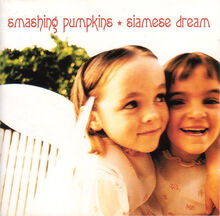
Recording sessions proper for Siamese Dream. Around 25 songs were finished, including the thirteen album tracks as well as a number of outtakes: "Apathy's Last Kiss", "French Movie Theme", "Hello Kitty Kat", "Pissant" and "Siamese Dream" were all b-sides; "Frail & Bedazzled", "Spaced" and "Whir" appeared on Pisces Iscariot; "Infinite Sadness" actually dates from these sessions, although released on the Mellon Collie triple vinyl; Earphoria's "Sinfony" might or might not have been tracked during these sessions. The in-studio improvisation "Where's Vince" and an unreleased alternate mix of "Spaceboy" which features James' slide guitar but no mellotron can be found on the unofficial Mashed Potatoes box set.
Butch Vig: We recorded Siamese Dream on analog tape, and looking back it's inconceivable how much work it took. Nowadays, in Pro Tools, it's so easy to slide things around to edit, cut, and paste. It makes the engineer's job so much easier. The great thing about how we approached Siamese Dream is – because we set the bar really high – we had to make sure everything sounded really good, and then the band had to play. They were great players, but we did a lot of takes. Sometimes I would do razor blade tape editing between takes – especially when they were cutting a basic track. Jimmy had to play drums a lot, and Billy had to play most of the guitar and bass on that record. There was a lot of burden, initially, just on getting the drums right; and once we had all that tracked, it really came down to Billy. It was just me and him in the control room, and it was immense, long hours – 12 to 14 hour days – of him playing guitar and singing. I had to keep him really motivated and focused to try to keep track of his vision. I've always loved working with bands that have a strong vision as a producer, and Billy Corgan had a very strong vision. I had never really done a record of that sonic scope. I remember it almost killed me, but was an immense achievement for me personally. Billy was a mad scientist with the guitars. A lot of times I would have to draw out a map, literally, of the song for his guitars with all these arrows, going, "Okay, this one goes to track 14 for the clean guitar through the second verse." For instance, on "Soma," that was one of the biggest guitar maps I ever had. I remember that was epic. I remember having to flip over the back of the track sheet and continue the map.[1]
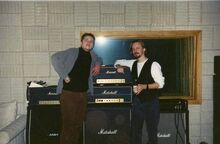
Butch Vig & Billy Corgan: “When we set out to make Siamese Dream, we wanted to go way, way over the top,” explains Vig. “We didn’t care if anybody thought it was overproduced.”
Tack a zero onto the Gish tab and you come close to matching Siamese Dream’s total cost. Through it all, the tenacity of the group’s work ethic was eclipsed only by the pressure to succeed. Along the way, Iha and Wretzky ended their relationship, Chamberlin developed what would become an acute substance abuse problem, and Corgan’s creative turmoil pushed him to the point of near suicide. His songwriting, as if voiced by a choleric yet optimistic teenager well beyond his years, hinged on defiance, acceptance, family, and alienation. Of the “hundreds of dumb riffs” they would play, the ones that stuck not only sounded good, they felt good to play.
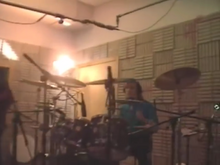
“I’m a person who tends not to repeat technique, which I guess is kind of suicidal in a way,” says Corgan. “Most people look at a recording career as a series of conclusions. I’ve always treated my recording career more like a journey. I think when any artist gets into a comfortable set of choices, that’s where the death of creativity lies.”
Months of recording meant lots of time for experimentation and tweaking. To help minimize distractions, Vig and the Pumpkins checked into Triclops Studios in Marietta, Georgia, a cozy space that allowed the band a sort of temporary respite. Unlike Smart, Triclops’ ’70s style room had high, woody ceilings that made for a modest decay. Vig brought along his API Lunchbox loaded with modular pres for the bass and a few guitar overdubs, but most of the instrumentation was run through the studio’s Neve console onto Studer A800s. Corgan’s “Soul Head” and Marshall cabinet were still in effect, but he no longer used the MP-1. Instead, Corgan achieved Siamese Dream’s highly stylized tone with a litany of DOD pedals and a ’70s-era, silver-faced Big Muff Pi. As the guitar he’d used on Gish had been stolen, his go-to guitars became ’57 Eric Clapton re-issue Strats with Lace Sensor pickups.
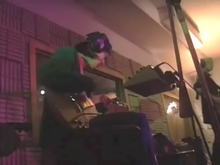
“We found a secret weapon on that record,” says Vig. “A little preamp in a pedal steel guitar. It wasn’t built for a loud guitar. It was built for a low output on a pedal steel, so it had this super high-end white noise gain that gave the guitar this sonic jet sound.”
That pedal steel preamp—coupled with an old school tape flanging created by physically speeding up and slowing down the reel by hand—is the sound behind Corgan’s otherworldly solo on “Cherub Rock.” “Quiet” features hard-panned left and right guitars running through the Big Muff with the tone turned all the way down, while the howling break in the chorus to “Mayonnaise” is nothing but pure feedback created by Corgan’s $60 pawn shop “Mayonnaise Guitar.”
But Corgan’s gear was only part of the equation. The endless overdubs— at least 40 in “Soma”—are well-documented, but Vig says that proper mic configuration is what allowed the parts to congeal. Vig’s miking technique was as follows: Corgan would crank up his amp to full gain, and then set the guitar down. After boosting the headphones send on all the mics, Vig entered the room to move around the mics, using the phase-shifting hiss from Corgan’s guitar echo as his guide. According to Vig, an AKG C 414 produced the widest spectrum of sound, a Sennheiser 421 accented the midrange, and ribbon mics were used to obtain a smoother sound with quick, yet mellow, transients.
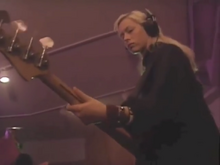
“You can’t have 40 guitars that are all full range,” says Vig. “There have to be places for them to fit. You could have low-midrange, or you could have everything scooped out with a high-pass that’s cut at 300 or 400kHz.”
The miking tactic seemed almost drum-like, which, given Vig’s musical expertise, is a fair assumption. “Maybe from me being a drummer, that’s an aesthetic I brought to the table that I didn’t even really understand at the time,” he says.
The army of guitar signals would later make vocal tracking a strenuous procedure for Corgan. Vig didn’t much care for the midrange in Corgan’s voice, so to soften that particular timbre he used a Shure SM7 (generally regarded as a more “open”-sounding mic when its rolloff and boost features are engaged simultaneously) through an API preamp and a Summit TLA-100 Tube Limiter, all fed back into Corgan’s headphones. Like everything else, vocal takes were abundant, with Corgan sometimes singing for eight hours at a time to make sure his tracks were pitch perfect.
“My voice is really hard to record,” says Corgan, smiling. “It’s hard to record, it’s hard to monitor, and it’s hard to mix. I’m Irish, I’m meant to sing sad ballads! My voice isn’t really meant for rock, and I’m pretty sure many people out there would agree with me.”
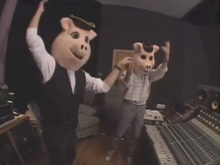
He laughs again, and you can hear it a little clearer. His voice. That voice, lurking underneath his conversational tone. That unmistakable inflection that can shift from an airy lilt to a nasal, sandpapery growl at the turn of a verse. To some it represents instant alternative rock salvation; a vocal uppercut to the face of the status quo. To others—Bruce Britt of the Broward-Palm Beach New Times, for instance—it’s the “most annoying voice in rock.” But Siamese Dream has gone four-times platinum on the strength of that voice because emotionally, it carries with it as much layered complexity and contradiction as the instrumentation that backs it. “Today” was the greatest day Corgan had ever known, not because it really was, but because it couldn’t get any worse. Somehow that was enough of a comfort to lure him away from the edge. Somehow, against all odds, the Smashing Pumpkins kept moving forward.[2]
It was over a year since I had watched Corgan lay down the overdubs for Siamese Dream at Triclops Sound Studios in Atlanta. He wasn't a pop star then just a very serious musician intent on calibrating every sonic aspect of the record. The overdubs were what producer Butch Vig called" backgroundy stuff, " those parts that swim around athletically in many slower Siamese Dream passages, softer counterparts of an overall guitar attack inspired, Corgan grinned "by the Gulf War."
The song "Soma" had been called "coma" that day. Iha's guitar had been rigged to vibrate an aqueous effect. It sounded at first too bright, then too analogies drenched for Corgan's ears. As Iha kept strumming three cords-"three cords, three cords, three cords," he'd actually begun to chant:"nice and smooth" Vig had coached- Corgan monitored the processor's readouts, puzzling over the effect's numerous numerical permeations. He and Vig finally found a sonic character that they liked.
"I want to try it one more time with a pick, " Corgan said. "We've been working on these stupid guitars for two days."
"They're not stupid, " Vig replied. the mood of that session was loose yet as goal oriented as any I'd attended, calm yet unapologetically intense. When at last corgan and Vig agreed to tape the effect, a phantom feedback noise showed up as well, not guitar and not keyboard in it's icy, inhuman character. Corgan, halfway out of the control room and eager to watch a football game on TV, stopped in his tracks. "I know what your going to say, " Vig said, lifting off his baseball cap. "right, " Corgan said "Let's get the feedback." Vig spent the next 45-minutes turning a knob until the feedback was properly phrased. "Okay, " he said. "It's done, now let's do some goddamn rocking' guitars." "I dun no, " said Corgan. "I'm feeling kind of wispy." He and the other Pumpkins set up in the tracking room to work on an arrangement of "Suicide Kiss", a song which never made it onto the record but was clearly very gulf war. Vig watched through the glass there was nothing wispy about it.[3]
Siamese Dream was 62 minutes in length and ran the gamut in sound and texture, from Today's poignant serenade to Cherub Rock's fearsome adrenaline blast. What it had over Gish was better songs and that guitar sound fuzzier than a deluxe set of Fuzzy Felt yet somehow ultra-disciplined, the sound of motorbikes in space. Gish had leant on a combination of ADA preamp and a 1984 JCM800, but the result was thin and redolent of conventional metal; Siamese Dream rediscovered the Electro-Harmonix Big Muff and when loads of fat fuzz wasn't quite fuzzy enough, employed the EH Microsynthesiser. But what the band and Dream producer Butch Vig refer to as the "super sonic fuzztone" - the foundation of Cherub Rock and Hummer-was more extreme still. An MSA fuzz unit was pulled out of an old
pedal steel guitar by Triclops sound engineer Mark Richardson and placed in a simple metal box. Even with the tone and gain controls rigged it up it didn't look like much. What it did though, was rock like a bitch.[4]
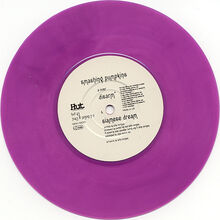
Butch Vig: Making Siamese Dream was really hard, because we felt a ton of pressure, and the band was pretty fragile. But Billy and I made a clear decision to swing for the stars, and make an ambitious statement, and I think we nailed it. There we days were it was fun, days were it was tedious, and days where it was crazy! I think the album still sounds good today, it holds up really well!
It was one of the most difficult albums I ever made, and one that I am very proud of. After the success of Nevermind and Gish, there was immense pressure on us to deliver something special. I pushed Billy hard…and he pushed me. There WERE days when it was fun, but also days where we felt like we had gone into the abyss. At the end of the album, we were both physically and emotionally exhausted. Alan Moulder had to leave on the last day of mixing (after we had kidnapped him for 6 straight weeks without a day off!) and Billy and I finished the last song Luna about 4 AM. There was no champagne, no high fives, no cheering…we just looked at each other and said "holy shit, are we finished?" and dragged ourselves back to the hotel. I woke up at noon the next day a the Beverly Garland Hotel on Vineland with all the curtains closed, and listened to the album all the way through in pitch black. I couldn't see anything, I could only listen…and I knew we had something special.
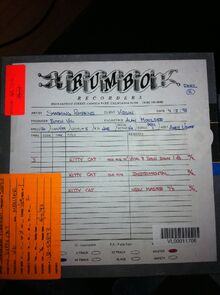
Butch Vig: The albums was recorded to 48 track, using two Studers. There was one song Mayonaise, that had so many tape edits, we found a digital multitrack (mitsubishi?) and transferred the song to it as our new master, cuz we were afraid the tape would break! No auto tuning…Billy would sing until he got it right. I would usually do comps with Jeff, old school style, punching the best bits onto a new master track. It was time consuming! I think Alan Moulder used some triggers when we mixed to add ambience to some of the songs…but we never replaced anything, and if we did use a trigger on the snare, it was probably a 70/30 % blend.
I can explain why we did so many edits. In rehearsals, I was timing the band around 145 bpm (as far as can remember). When we tracked it, we used a click, and Billy though it sounded too fast. So we slowed it down to around 141 or so. After we recorded what I thought was the master take, I started to notice certain snare hits that dragged. So I measured where the kick landed with a china marker on tape, then measured where the snare landed. The bars that felt good to me, were in fact around 145 bpm. So Jeff and I went through and starting shaving any snare that dragged forward. And we went in kinda deep! There were probably 200 edits when we were finished! The song was recorded at 141 but ended up at 145! After 200 edits I looked at Jeff and said "Is it Sweet?
Jeff Tomei: Triclops studio was used because of 2 main reasons, it was not LA and they had a beautiful sounding Neve 8068. I believe Butch sought the studio for the board and wanted to keep the band away from distractions like there would be in LA.
Butch Vig: Exactly, that's why we chose the studio…that Neve was a kickass sounding, and we thought we would be isolated enough to keep the distractions low. However, within 24 hours Jimmy new every drug dealer, hooker, bookie, and nut case in Atlanta…so that part of the plan didn't work!
Jeff Tomei: It was recorded on a Neve 8068. The history of that board (at least 1/2 of the board) is that it came from A&R studios in NY and John Lennon recorded on it. I have seen the picture of Lennon behind it. As far as the mix, Butch would know as I was not there.
Butch Vig: The album was mixed at Rumbo in Los Angeles…the studio owned by The Captain and Tennille (the Captain used to practice fly fishing off the roof)….I think the console was a Neve VR. That board at Triclops was really big sounding!
Jeff Tomei: Ampex 456 30ips no NR. I believe the Studer was set up at +6 @185. We went through 40 reels of 2″ between "B"Reels and safeties.
Butch Vig: Billy has a really good ear, and he was just as opinionated about the sound as I was. Most of the time, he knew what he wanted, but sometimes it took a while to get the sound. A lot of experimenting. Sometimes I would suggest and idea, and it would take hours to get the right sound.
Billy is a GREAT guitarist….some of the parts came really fast, others were a struggle: the intro for Today took a LOT of takes to get the perfect sound and feel. Remember, this is before Pro Tools, and that guitar is naked at the start of the song…I think we worked on that 4 bar intro for about 12 hours!!!!
Vocals were time consuming. Billy would do a lot of of takes, I would give him feedback and keep notes until I was satisfied we had the right performance. Then Jeff and I would do a vocal comp, bouncing the best bits to another track. We didn't use auto-tune (it didn't exist!) so I just went for what I thought had the best feel. There are spots on the album where the vocal is not pitch perfect, but that's not the point…I was looking for an emotional quality in his singing….Billy has this ability to open his heart, so to speak, and sing with a vulnerability that draws you into the song. That was more important to me than technical perfection.
Siamese Dream is a very dry record, very little reverb used on guitars and vocals. And we seldom used ambient mics on the guitars. The one efx we used a lot on Billy's voice was the Eventide harmonizer, to add a slight double effect. Usually 20 or 30 ms delay, with about a 10 cent pitch offset.
Butch Vig on guitar overdubs: Oh yes, there were a LOT of guitars! Because we were using analog tape, and had most of the guitars on the 2nd reel, we had to punch in different parts in different sections, sometimes submixing 8 or 12 guitars down to stereo…(this is before Pro Tools)…I remember some songs like Hummer and Soma had so many parts, I had to make "guitar maps" for us to remember how to approach the mix. Alan Moulder asked "what is a guitar map?" He knew what a guitar map was after he'd been kidnapped for 6 weeks!
We would usually record the guitars with their full sound, then filter them through and eq, sometimes the Neve, sometimes the API…ahhhhh, I think thwy had some pultecs there…and even some of the guitars went through my Akai sampler. I think we had 4 mics on the guitars…Jeff might remember…we'd make sure the phase was good, and then pick the best one or sometime 2 blended. I had this trick I would do when setting up mics…I'd turn the amp on full blast so there is a lot of static noise coming from the speaker, then I'd put headphones on and turn up the mic level to the headphone mix really loud. Then I'd get down in front of the speaker and listen to how the hiss sounded. You can hear the top, mids, bottom in the headphones depending on where you move the mic, and I would place it where I thought I found the sweet spot.
I think Soma and Hummer had closer to 40 guitar tracks. Not all playing at the same time, but there could be 8-10 overdubs in one section, then another 8-10 in a second section, etc. A lot of times we would bounce them down…like in the ebow part, I think that was around 12 tracks mixed down to stereo.
Jeff Tomei: I remember the intro guitar that James played (and he played very little on the record) on Mayonaise took even longer than Today. The main problem was the band was pretty insistent in playing their instruments. This guitar James had was a Kingston he got in a pawn shop. The intonation was terrible and we had to do a lot of tuning for the chords. The bridge was kind of like an old tele where each 2 strings share so you had to compromise on the intonation I seem to remember. The feedback guitar the you hear in the pauses in the song was a Kimberley. The pickups were so microphonic and we had Billy play in front of the cab. As a side note, it is also the guitar we used as a drum room mic on the song "Pissant" from Pisces Iscariot.
It is pretty well known that Billy played most of the guitars on SD. He played bass on every song but "Luna" I believe. My opinion as to why, is that Billy knew pretty much what he wanted. In all fairness to James and D'arcy, there is no way to get inside someone else's head and play exactly what they envision. I also don't think that they were as prepared for the record as Billy. Again this is just my opinion. I am sure Butch can elaborate more on this.
We did track all songs as a band with the exception of some "B" sides. Billy would go in after we had the final drum edit and put the bass, guitars and vocals on. I recall we would work on 2 songs at a time and get them to about 80% before tracking more basics.
Butch Vig on vocal mics and effects: I think we used an SM7 a lot…and I had an API Lunchbox that I used for vocals at that time for the pre…I would add a little air at the top, and usually cut a bit of mid around 800 hz…. And I probably used my Summit TLA 100 comp. But I seem to remember Billy used a large tube mic on a couple songs…hmmmm. Jeff will probably remember better than me!
There's very little effect on Billy's voice, I think we used a little bit of Eventide harmonizer as a doubler, set to around 30ms. Alan Moulder might have added a bit of room in the mix, but Billy and I didn't like reverb. We did dbl his voice and add harmonies when we recorded the song.
Jeff Tomei on vocal mics: I do remember that we used a tube 47 on one or two songs but found that the SM7 was better for his voice. I remember the vocal comps taking quite a bit of time as all the vocals were doubled. Once we had the main comp, we then had to create the double.
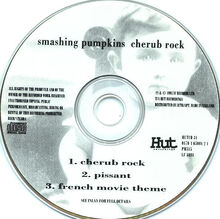
Jeff Tomei on the snare sound: Actually I remember we mostly used Jimmy's Radio King snare. The biggest thing to the sound was how well it and all of the drums were tuned. Butch was absolutely amazing at tuning the drums. As far as the snare in the mixing, Butch can shed some light on that. I was not around for the mix. [According to Jimmy Chamberlin, the 1939 Radio King and Pearl 6.5″ Chrome Free-Floater were used on "Today"]
Butch Vig: Jimmy is a GREAT drummer, he has some amazing chops. He does not hit the drums really hard, but he has excellent dynamic control over the whole kit, and sort of mixes himself. We probably could have used 4 mics and he would have sounded amazing.
Butch Vig on "Quiet intro": The intro is 3 or 4 short guitar licks that we ran into the K2500 and processed heavily. We didn't use midi, so I had to "fly" the bits back to tape pushing the trigger button…it was tricky to get the timing right.
Jeff Tomei on "Today" intro: That amp was this old no name combo that Mark Richarsdon owned. I think it was something he put together. It had an old original Jensen 10″ or 12″ speaker. The speaker was later fried when, in a tired state, Mark hooked the power cable up to the speaker as he was doing some work on it. When he plugged it in…..zap, speaker gone.
Jeff Tomei on "Hummer" intro: The sitar was a coral sitar that belonged to a musician named Jeff Calder in an Atlanta band called the Swimming Pool Qs. We never recorded the real Sitar Billy brought in. I seem to remember Butch making a Loop in his Akai S-1000 but don't remember the details much. I think Billy played it through an amp to get the distortion.
Jeff Tomei on "Disarm": The Acoustic was Billy's Ovation (not my favorite to record). I really don't remember the mic, it may have been the tube 47 or even an AKG 414. I know we spent a long time getting the sound because Ovations just don't record well for me. Billy actually got tired/frustrated because of the time issue that he had James Iha play for a bit. When we finally were set on the sound, Billy went back in the booth and the guitar sounded totally different. The thing I learned with that was because Billy is a big guy and James was not, the guitar resonated more with James. By Billy hunkering down over the guitar, it made it darker and less resonant. We had dialed the sound in for James' playing style. Very frustrating in the end and I still don't like the sound of that acoustic on the record.
Butch Vig on "Disarm": I think we used 1176 or dbx160 on the acoustic…Jeff, didn't you talk about Billy's acoustic earlier? I was not crazy about how it sounded…it was kind of dark. It sounds good on the album, but we had to eq it a lot. I also remember Billy wore a bracelet most of the time, and sometimes the mic would pick it up. I can hear it a little bit in "Spaceboy"…almost like percussion. I can hear it distinctly on Gish in "Daydream".
Jeff Tomei on "Spaceboy": Mellotrons were notorious for their tuning problems. This was actually a really good one and it had 3 or 4 different tapes you could put in. I hesitate to call them cartridges because they were so big. The tapes were really old and some had been broken so they had less time and some notes did not work all of the time. You had to get in and adjust where the tape heads come in contact with the tape. I do remember Butch was concerned with the tuning but Billy just wanted to get it done. Also the tuning on them was hit or miss with one knob that was hard to get in and stay in the sweet spot. As a side note, James Iha bought that one. It belonged to Triclops studio where we tracked the record.
Butch Vig on "Spaceboy": Is the Spaceboy mellotron sharp? It could be…it was a very tempermental mellotron! The cool thing about that song is that is has a really cool vibe…it's kinda loose…but it feels really great. And I think Billy's vocals are breathtaking. Billy played the mellotron, and I remember that at the time I thought some of the parts he played were quite odd (he's not a keyboard player)…but now, they all make sense to me!
Jeff Tomei on string overdubs: We had 1 violin and 1 cello player. We stacked them about 15 or 20 times and had to record to a "C" and bounce stereo pairs back to the "B" reel. I think we used a tube 47 or a Neumann fet 47 for the Cello and maybe a Sony C37A for the violin. Nothing synthetic though, just many, many stacks.
Butch Vig on string overdubs: The funny thing is, we originally wanted to make the strings sound like a quartet, so we should have only needed a couple takes. But after listening to them double the first part, we realized the song was going to sound much bigger and dynamic with a LOT of strings. In hindsight, we probably could have got a 16 piece or 20 piece string section and done it live, but hey, what did we know…we were making it up on the fly!
Jeff Tomei on outtakes: I'm sure Butch knows but it probably just did not make the cut for the final. It is sometimes difficult to know what goes on and what does not. We tracked 26 songs I believe during that time. 13 made it on SD and 6 are on PI. One interesting thing is that we cut a "B" side song that was just Billy on Mellotron and Jimmy on drums. I remember asking Billy what the title was and he said "Mellon Collie and the Infinite Sadness". Somewhere on a 2″ tape box is that song title years before that actual record came out.[5]
In the time it took to record the album, Smashing Pumpkins recorded 25 songs- 13 for the album, 12 for B-sides and bonuses. On top of that, Corgan wrote another 15. "So that's 40 songs I wrote, and a lot of them are interesting for various reasons. But they're not brilliant, and I do wrestle with that, quality over quantity." Right now, quantity wins because the market demands it. Corgan just hopes that the quality will shine through regardless. "How important are B-sides anyway?"[6]
Butch Vig sent us out into the tracking room and said, 'Play something while I get some tones.' So there's this hour-plus DAT of us just fucking off, and during the middle of us fucking off, which really doesn't go anywhere, suddenly we're playing Sweet Home Alabama. Don't ask me why. "I didn't know the lyrics. Obviously, we were just joking around. But that's the kind of thing we can put up on Facebook. A bit too much has been made of the track. Really, it was just us fucking off – we didn't even know how the song went. It was kind of a rough homage. But because of the deal we have with EMI, even if I wanted to put it out on Facebook for a laugh, I could. We don't have to go through all of these channels, other than paying Lynyrd Skynyrd a publishing rate. "That's the really exciting thing about this new deal: there are no limitations to what we can do. I can only think of a few bands in the world that have the ability to access anything that's theirs and do with
it what they want."[7]
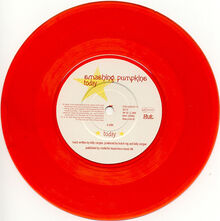
Billy Corgan: The studio we are working in is about 20+ minutes outside of Atlanta proper, a distance that escapes us as being too far to have any kind of social life…our first thought of course is to where we would be able to hang out on a nightly basis, and with Atlanta looming just over the horizon, we figured fun was a sure bet (wrong!)…little did we know we were in the beehive of the very white deep south, Marietta, Georgia…we are set up in one of those temporary living communities, where people rent month to month in case they have to leave suddenly…James and D’arcy share one apartment, while Jimmy, Vince, and I share other…James and D’arcy’s place is about a 3 minute drive from ours, which adds to the sense of isolation between the two camps and insures that outside of work, we will almost never see each other…our roommate Vince is one of James’ high school buddies turned employee, and his job is to take care of whatever (whatever breaks, whatever needs to get done---prompting the infamous jam/rant song “where’s vince?”)…
In order to save some money, our first order of business is to spend some quality time with Butch Vig (our producer) in an Atlanta rehearsal space, to go over all the songs and weed out what is in or out…Butch sets up a portable make-shift studio to record us for later reference, and we get to work for a few days in earnest…this is pretty much a repeat of how we work at home, just doing a lot of chopping and cutting and last second lyric scribbling…to add a little something to the sense of urgency, we have booked 4 shows at a local club, hoping that the combo of working with Butch first and the concerts second will get us in gear and over the final hump to fully prepare the songs to be recorded…James and D’arcy are much more comfortable with Butch around because they feel that there is someone new to pay attention to them and heed any of their concerns…this is something Jimmy and I silently find amusing, because there is a bit of a show to the whole thing that we are long bored with…behind the scenes, there is one way we do business, but in front of anyone else, it’s just a charade that I tolerate…
Because we have been cooped up for so long, the shows go fairly well energetically but are a bit of a train wreck musically…without forethought, we have transferred our normal practice set-ups to the stage, which means we are using the Big Muff fuzz pedals live…this proves to be a fatal mistake, because without the density of a small room around us, our guitars sound very thin and undefined rendering us sloppy and loose…jumpy nerves add to muddled arrangements, missed opportunities, and to top it all off, most of the songs do not have any lyrics…I skate by by singing my normal in-practice pig-latin, which to someone not paying much attention sounds relatively close to the actual English language…
The recording studio itself sits coyly in a very normal office complex…built by total vintage gearheads, our attraction to the place is simple: away from Chicago, able to make the ‘old’ tube sound…the control room is about standard size, which means it fits about 4 people comfortably, 5 is a stretch…the actual tracking room is a prolonged concrete rectangle, acoustically designed for maximum volume and deadly booming drums (for those interested, you can see this studio fairly well in our home video ‘vieuphoria’)…we spend a few days moving the drums around from wall to wall, hoping to find the optimal sonic spot for Jimmy to play in…we end up opting for a back corner, and from that point on, he never moves…for the tracking, we set-up in a variation of our circle, with me in front of Jimmy, and James and D’arcy off to my left and Jimmy’s right…our amps sit in small isolation booths to keep the sound from bleeding in on the drums, and we all have to wear headphones…standard procedure is to pick a song, and focus on arrangement and drum tones…for Jimmy, the snare he uses on a particular song is a big deal, so he and Butch spend a lot of time going back and forth about this head or that cymbal…then we’ll play for a bit, go and listen to the takes, and then make last-second verbal changes…once we all agree upon a ‘final’ arrangement, we play together until one of 3 things happens: we get the take all playing together, we don’t get the take all playing together, or Jimmy complains to me that James and D’arcy’s playing is throwing him off and asks me to remove them from playing along at all…there are various incarnations of the third option, which could be Jimmy asking Butch to town them down in the headphones, or asking me to lose James but keep D’arcy or the other way around...because this is a new album and a fresh opportunity, there is a sense in the air that this time around the recording and the associated processes will be different…any variation in the beginning of the album of the ‘let’s all do it together’ concept causes immediate tension, and Butch is squarely placed in the middle...this is something I bristle at, but at the same time realize that it is possibly a means to an end…James has a very good memory, and the recording issues with him normally center around timing and tightness…D’arcy on the other hand commonly gets completely lost, which throws off Jimmy’s concentration, blowing the take…in addition, he hates her sense of timing, and the way it makes his drum takes fly all over (we know as we record that we will not keep anything that the 3 of us record, we are simply there to assist Jimmy to play with the right ‘feel’)...I try to keep the peace, but quickly realize that the old way, which is essentially me and Jimmy, is still the easiest way across…I privately express to Jimmy that I understand his growing frustration, but to pace himself because it is going to be a long recording process…
After a lot of discussion, Butch and I agree that the best way to save time is to get all of Jimmy’s drum parts done first, before we start to zero in on the bass, guitars, and vocals…Butch, coming off the huge sales of Nirvana’s ‘Nevermind’ album, has become even more obsessed with perfectionism as a means to success...where on our first album ‘Gish’, because of time and money, many of Jimmy’s drums were done in just one take, now Butch wants more...with the stakes and budget being much higher, he now pushes Jimmy to a level of idealism that he has never asked of any other drummer...being a drummer himself, Butch picks up on subtle nuances that would escape me, and therefore doesn’t allow Jimmy to get by with less than his best...at first, it becomes a gentle ribbing contest between the two, with Butch tweaking Jimmy that he can do better, and Jimmy pushing back by saying Butch couldn’t even attempt half of what he (Jimmy) is doing...even when Jimmy does a great take, Butch takes the 24 track master and slices it up with a razor blade to create an even more perfect version that no human could accomplish...this sets such a high standard for Jimmy that he begins to lose confidence in himself, and this translates into him making mental errors in arrangements, so focused is he now on perfect timing...because Jimmy is a total savant on the drums, he has never had to examine his playing to this degree before, because drums have come so readily to him...Jimmy starts communicating to me that he cannot handle the pressure, and this adds to his lack of patience with James and D’arcy...whereupon, they start complaining to Butch...and this is the way the circle starts to go round...[8]
Billy Corgan: As our days grind on in the studio, all pressure is mounting on Jimmy…the success of every session weighs solely on his shoulders, something he is not used to…the big question every day sits whether he can top himself and play better than he has ever played in his life…we are counting on him to finish all the drums first, and I can tell that even though he is putting on a brave face, this type of microscopic attention is starting to freak him out…Jimmy is the type of musician who is at his best if he is not thinking…this doesn’t mean he doesn’t know what he is doing at any given moment (he does), but rather what he does is so complicated that it’s best if he doesn’t pay too much attention, a act like juggling with dangerous objects…because you can juggle 4 knives fairly effectively if you really don’t pay much attention to the fact that you are juggling 4 sharp knives…and this is what it is like for him, playing some of these songs at 100mph…I look for ways to help him, and notice if I give him too many details after a take, he plays worse and worse, overburdened by thought…also, he doesn’t play well if you criticize him openly particularly, or directly, but responds really well to overall grand concepts and encouragement…the general feeling for me when I work with Jimmy is one of true honor…he will absolutely kill himself and play his fingers to the bone trying to get you what you want musically, if you will walk with him thru the darkness of the whole ordeal…take after take strips Jimmy of his natural confidence, and I try to stay in the spot with him, reminding him of how far we have come, and how we are both going to get there…we start to speak a secret language no one hears, not even Butch over the open mikes…James and D’arcy don’t say a word, either because they don’t understand or don’t care, as this part of the process becomes mine and Jimmy’s exclusively…I spend a lot of energy trying to soothe him, to get him to play consistently so that we won’t have to chop up all his drum takes so much, both because the editing is so time consuming (sometimes a whole day) and the very act of slicing apart his grooves destroys his urgent swagger, killing the bands natural feel…I secretly go along with all this idealism, believing in Butch and how it will get us all where we want to go…unknowingly, I am deftly balancing two worlds on a pin, one the world of the mighty Pumpkins and our sloppy yet defined passion, the other the growing perfectionism of a coming corporate age…
To break up some of the incessant drum takes, we focus some on bass and guitar sounds, doing lots of tests with microphones and pre-amps, guitars and speakers, to try to bring the overall picture into a clear vision that seems readily achievable…although we have a fairly large budget (precisely 8 times larger than our first), money is being eaten up rapidly by the accommodations and studio time…even at this fairly early stage, we are already behind schedule and by logic over budget (if you calculate it out)…as is their custom, James and D’arcy pay little attention to these ‘tests’, leaving the technical aspects to Butch and I…since this is now our way of giving Jimmy a break, he is generally not even at the studio during this work…
Jimmy starts to lose it, regressing back into hanging out with losers and making quick friends with local addicts…I had hoped that by coming down to Atlanta (my real reason for getting out of Chicago) that we could keep him isolated from these types of temptations and stay focused…at first, it is a few simple ‘I had a few too many’ mornings, and we work around his hangovers and sudden ‘flu-like’ symptoms…but you can see the storm cloud coming, because he gets this certain look in his eye…at night, I try to engage him by playing video game baseball against him, and we have some wonderful times beating up on each other, each claiming his own bragging rights…many evenings, he just comes home and goes right to bed…but like some hidden clockwork, a ‘friend’ will suddenly appear at the studio to take him into ‘Hot-lanta’ for a night on the town, and he’s gone, quicker than you can say ‘wait’…this has a strange rhythm to it, these calm days and sad, crazy nights, and it is something you can get used to, like a tax you learn to pay…this is all manageable of course…that is until he disappears without a trace…[9]
Return to Siamese Dream
- ↑ Jake Brown, "Smashing Pumpkins: A Studio History", Tape-Op, Sept/Oct 2016
- ↑ Richard Thomas, "Signal To Noise: The Sonic Diary Of The Smashing Pumpkins", Electronic Musician, October 1st, 2008
- ↑ James Hunter, "The Pumpkins Won't Be Smashed", Musician, July 1994
- ↑ Danny Eccleston, "Gourd Vibrations", TGM Magazine, December 1995
- ↑ Butch Vig & Jeff Tomei, online Interview, Gearslutz forum, June 2009
- ↑ Dave Thompson, "Local Geek Makes Good", Creem, Jan/Feb 1994
- ↑ Joe Bosso, "Billy Corgan talks Smashing Pumpkins reissues, new studio album", Music Radar, April 11, 2011
- ↑ Billy Corgan, "2 Sets of Siamese Twins", livejournal, May 6th, 2005
- ↑ Billy Corgan, "The March of Sherman", livejournal, May 10th, 2005